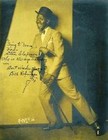Written by Jerry Jeff Walker's ..Dedicated to the memories of Bill 'Bojangles' Robinson 1878 - 1949 .. For more about Bill Robinson, click on the Lyrics/Story page above.
church
storyteller
classic country
red sovine
Creative Commons license
Commercial uses of this track are NOT allowed
Adaptations of this track are NOT allowed to be shared
You must attribute the work in the manner specified by the artist
Story behind the song
(Song edited and remix by Tom Tripp)
Bill "Bojangles" Robinson (May 25, 1878 – November 25, 1949) was a pioneer and pre-eminent African-American tap dance performer.
BILL ROBINSON
Born in Richmond, Virginia on May 25, 1878, to Maxwell Robinson, a machine-shop worker , and Maria Robinson, a choir singer, Bill Robinson was brought up by his grandmother after the death of his parents when he was still a baby. He was christened Luther, a name he did not like, so he suggested to his younger brother Bill that they should exchange names. When Bill objected, Luther applied his fists, and the exchange was made! (The new 'Luther' later adopted the name Percy and became a well-known drummer.) The details of Robinson's early life are known only through legend, much of it perpetuated by Bill Robinson himself.
At the age of six he began dancing for a living, appearing as a "hoofer," or song-and-dance man, in local beer gardens. Two years later, in Washington, DC he toured with Mayme Remington's troupe. In 1891, at the ripe age of 12, he joined a traveling company in "The South Before the War", and in 1905 worked with George Cooper as a vaudeville team. He gained great success as a nightclub and musical comedy performer, and during the next 25 years became one of the toasts of Broadway. Not until he was fifty did he dance for white audiences, having devoted his early career exclusively to appearances on the black theater circuit.
In 1908 in Chicago he met Marty Forkins, who became his lifelong manager. Under Forkins' tutelage Robinson matured and began working as a solo act in nightclubs, increasing his earnings to an estimated $3500 per week. The publicity that gradually came to surround him included the creation of his famous "stair dance" (which he claimed to have invented on the spur of the moment when he was receiving some honor--he could never remember exactly what-- from the King of England. The King was standing at the top of a flight of stairs, and Bojangles' feet just danced up to be honored), his successful gambling exploits, his prodigious charity, his ability to run backward (he set a world's record of 8.2 seconds for the 75-yard backward dash!) and to consume ice-cream by the quart, his argot--most notably the neologism "copasetic"--and such stunts as dancing down Broadway in 1939 from Columbus Circle to 44th St. in celebration of his 61st birthday.
Because his public image became preeminent, little is known of his first marriage to Fannie S. Clay in Chicago shortly after World War I, his divorce in 1943, or his marriage to Elaine Plaines on January 27, 1944, in Columbus, Ohio.
Toward the end of the vaudeville era a white impresario, Lew Leslie, produced "Blackbirds of 1928," a black revue for white audiences featuring Robinson and other black stars. From then on his public role was that of a dapper, smiling, plaid-suited ambassador to the white world, maintaining a tenuous connection with the black show-business circles through his continuing patronage of the Hoofer's Club, an entertainer's haven in Harlem. Consequently, blacks and whites developed differing opinions of him. To whites, for example, his nickname "Bojangles" meant happy-go-lucky, while the black variety artist Tom Flatcher claimed it was slang for "squabbler." Political figures and celebrities appointed him an honorary mayor of Harlem, a lifetime member of policemen's associations and fraternal orders, and a mascot of the New York Giants baseball team. Robinson reciprocated with open handed generosity and frequently credited the white dancer James Barton for his contribution to Robinson's dancing style.
After 1930 black revues waned in popularity, but Robinson remained in vogue with white audiences for more than a decade in some fourteen motion pictures produced by such companies as RKO, 20th Century Fox and Paramount. Most of them had musical settings, in which he played ol
